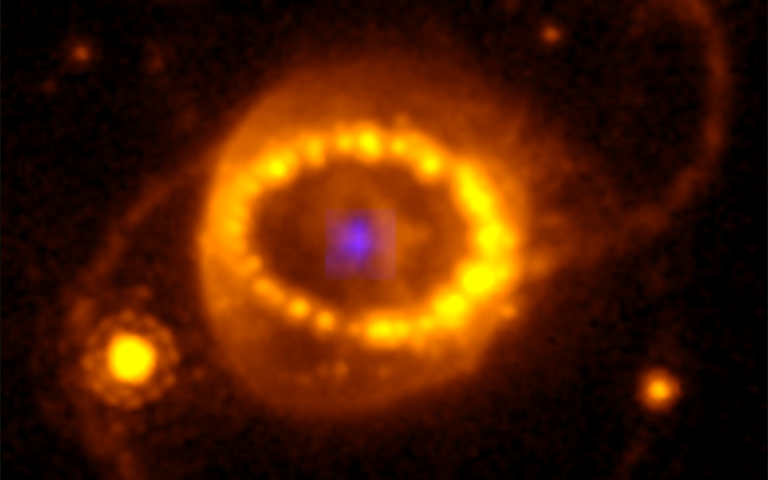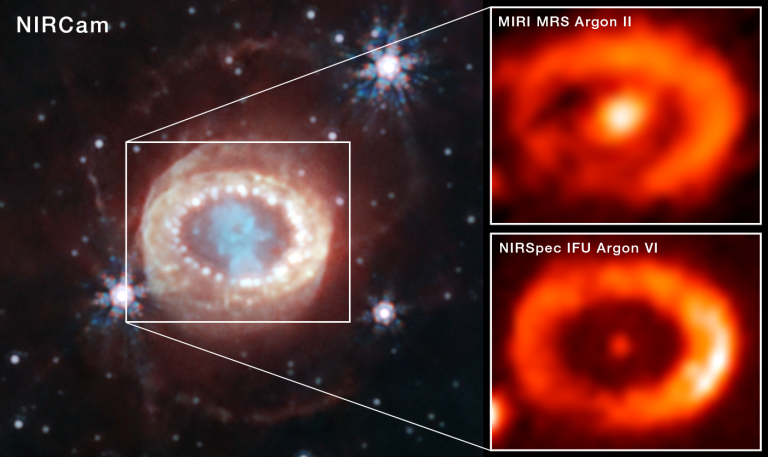Newly born neutron star detected in nearby supernova
22 February 2024
An international team of astronomers, including our very own Professor Mike Barlow, have discovered the first conclusive evidence that a neutron star exists at the centre of Supernova 1987A, a star explosion observed 37 years ago.

Supernovae are the spectacular end result of the collapse of stars more massive than 8-10 times the mass of the sun. They are the main sources of chemical elements (such as carbon, oxygen, silicon, and iron) that make life possible. The collapsed core of these exploding stars can result in much smaller neutron stars, composed of the densest matter in the known universe, or black holes.
Supernova 1987A, located in the Large Magellanic Cloud, a neighbouring dwarf galaxy, was the nearest, brightest supernova seen in the night sky in 400 years.
Neutrinos, unimaginably small sub-atomic particles, were produced in the supernova and detected on Earth (23 February, 1987) the day before the supernova was seen, indicating that a neutron star must have formed. However, it has not been known whether the neutron star persisted or collapsed into a black hole, as the star has been obscured by dust that formed after the explosion.
In the new study, published in the journal Science, researchers used two instruments on the James Webb Space Telescope (JWST), MIRI and NIRSpec, to observe the supernova at infrared wavelengths and found evidence of heavy argon and sulphur atoms whose outer electrons had been stripped off (i.e. the atoms had been ionised) close to where the star explosion occurred.
The team modelled various scenarios and found that these atoms could only have been ionised by ultra-violet and X-ray radiation from a hot cooling neutron star or, alternatively, from the winds of relativistic particles accelerated by a rapidly rotating neutron star and interacting with surrounding supernova material (pulsar wind nebula).
If the former scenario is true, the surface of the neutron star would be about a million degrees, having cooled down from 100 billion degrees or so at the moment of formation at the core of the collapse more than 30 years earlier.
Co-author Professor Mike Barlow (UCL Physics & Astronomy) said: “Our detection with James Webb’s MIRI and NIRSpec spectrometers of strong ionised argon and sulphur emission lines from the very centre of the nebula that surrounds Supernova 1987A is direct evidence of the presence of a central source of ionising radiation. Our data can only be fitted with a neutron star as the power source of that ionising radiation.
“This radiation can be emitted from the million degree surface of the hot neutron star, as well as by a pulsar wind nebula that could have been created if the neutron star is rapidly spinning and dragging charged particles around it.
“The mystery over whether a neutron star is hiding in the dust has lasted for more than 30 years and it is exciting that we have solved it.
“Supernovae are the main sources of chemical elements that make life possible – so we want to get our models of them right. There is no other object like the neutron star in Supernova 1987A, so close to us and having formed so recently. Because the material surrounding it is expanding, we will see more of it as time goes on.”

Professor Claes Fransson (Stockholm University, Sweden), the lead author of the study, said: “Thanks to the superb spatial resolution and excellent instruments on JWST we have, for the first time, been able to probe the centre of the supernova and what was created there.
“We now know that there is a compact source of ionising radiation, most likely by a neutron star. We have been looking for this from the time of the explosion, but had to wait for JWST to be able to verify the predictions.”
Dr Patrick Kavanagh (Maynooth University, Ireland), another author of the study, said: “It was so exciting looking at the JWST observations of SN 1987A for the first time. As we checked the MIRI and NIRSpec data, the very bright emission from argon at the centre of SN 1987A jumped out. We knew immediately that this was something special that could finally answer the question on the nature of the compact object.”
Professor Josefin Larsson (Royal Institute of Technology (KTH), Sweden), a co-author of the study, said: “This supernova keeps offering us surprises. Nobody had predicted that the compact object would be detected through a super strong emission line from argon, so it's kind of amusing that that’s how we found it in the JWST.”
Models indicate that heavy argon and sulphur atoms are produced in great abundance due to nucleosynthesis inside massive stars immediately before they explode.
While most of the mass of the exploding star is now expanding at up to 10,000 km/second, and is distributed over a large volume, the ionised argon and sulphur atoms were observed at close to the centre where the explosion occurred.
The ultraviolet and X-ray radiation which is thought to have ionised the atoms was predicted in 1992 as a unique signature of a newly created neutron star.
These ionised atoms were detected by James Webb’s MIRI and NIRSpec instruments using a technique called spectroscopy, where light is dispersed into a spectrum, enabling astronomers to measure light at different wavelengths to determine an object’s physical properties, including its chemical composition.
A UCL team at the Mullard Space Science Laboratory designed and built NIRSpec’s Calibration Source, which allows the instrument to make more precise measurements by providing an even, reference illumination of its detectors.
The new study involved researchers from the UK, Ireland, Sweden, France, Germany, the United States, the Netherlands, Belgium, Switzerland, Austria, Spain and Denmark.
About Supernova (SN) 1987A
SN 1987A is the most studied and best observed supernova of all.
Exploding on February 23 1987 in the Large Magellanic Cloud in the southern sky at a distance of 160,000 light years, it was the closest supernova since the last naked eye supernova observed by Johannes Kepler in 1604. For several months before it faded SN 1987A could be seen with the naked eye even at this distance.
Even more importantly, it is the only supernova to have been detected via its neutrinos. This is highly significant since 99.9 % of the enormous energy emitted in this event was predicted to be lost as these extremely weakly interacting particles.
The remaining 0.1 % appears in the expansion energy of the remnant and as light. Of the huge number (about 10 to the power 58) of neutrinos emitted, about 20 were detected by three different detectors around the Earth, from the collapse in the core of the star on February 23 at 7:35:35 UT.
SN 1987A was also the first supernova where the star which exploded could be identified from images that had been taken before the explosion. Besides the neutrinos, the most interesting result of the collapse and explosion is the prediction that a black hole or neutron star was created. This constitutes only the central core of the collapsed star, with a mass of 1.5 times that of the Sun. The rest is expelled with a velocity up to 10% of the speed of light, forming the expanding remnant we observe directly today.
The ‘long’ 10 second duration of the neutrino burst indicated the formation of a neutron star, but despite several interesting indications from radio and X-ray observations, no conclusive evidence for a compact object had been found until now, and was the main remaining unsolved problem for SN 1987A.
An important reason for this may be the large mass of dust particles that we know was formed during the years after explosion. This dust could block most of the visible light from the centre and therefore hide the compact object at visible wavelengths.
Two scenarios of neutron star
In their study the authors discuss two main possibilities: either radiation from the hot, million degree newly born neutron star or, alternatively, radiation from energetic particles accelerated in the strong magnetic field from the rapidly rotating neutron star (pulsar). This is the same mechanism as operates in the famous Crab nebula with its pulsar in the centre, which is the remnant of the supernova observed by Chinese astronomers in 1054.
Models of these two scenarios result in similar predictions for the spectrum, which agree well with the observations, but are difficult to distinguish. Further observations with JWST and ground-based telescopes in visible light, as well as the Hubble Space Telescope, may be able to distinguish these models.
Links
- The paper in the journal Science
- Professor Mike Barlow’s academic profile
- UCL Physics & Astronomy
- UCL Mathematical & Physical Sciences
Images
- Top: The combination of a Hubble Space Telescope image of SN 1987A and the compact argon source. The faint blue source in the centre is the emission from the compact source detected with the JWST/NIRSpec instrument. Outside this is the stellar debris, containing most of the mass, expanding at thousands of km per second. The inner bright “string of pearls” is the gas from the outer layers of the star that was expelled about 20,000 years before the final explosion. Fast debris is now colliding with the ring, explaining the bright spots. Outside of the inner ring are two outer rings, presumably produced by the same process as formed the inner ring. The bright stars to the left and right of the inner ring are unrelated to the supernova.
Credit: Hubble Space Telescope WFPC-3/James Webb Space Telescope NIRSpec/J. Larsson
- Middle: The top image features the data from Webb’s MRS (Medium Resolution Spectrograph) mode of the MIRI instrument (Mid-InfraRed Instrument). The bottom image depicts data from Webb’s NIRSpec (Near Infrared Spectrograph) at shorter wavelengths. Spectral analysis of the MIRI results showed a strong signal due to ionised argon from the centre of the ejected material that surrounds the original site of SN 1987A. The NIRSpec data found even more heavily ionised chemical species, particularly five times ionised argon (meaning argon atoms that have lost five of their 18 electrons). Weak lines of ionised sulphur were also detected with MIRI. This indicated to the science team that there is a source of high-energy radiation in the centre of the SN 1987A remnant, illuminating an almost point-like region in the centre. The most likely source is believed to be a newly born neutron star.
Credit: NASA, ESA, CSA, and C. Fransson (Stockholm University), M. Matsuura (Cardiff University), M. J. Barlow (University College London), P. J. Kavanagh (Maynooth University), J. Larsson (KTH Royal Institute of Technology)
 Close
Close

